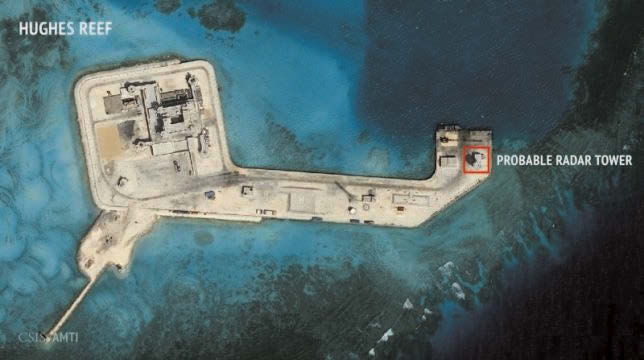
The Dispute – Approximately 3.5 million square km area of the South China Sea has been under dispute as China, the Philippines, Vietnam, Malaysia, Taiwan and Brunei have all claimed sovereignty over this territory. This area of the sea is rich in oil and gas fields.
In a major diplomatic blow to China, the Permanent Court of Arbitration struck down the Communist giant’s claims in the strategic South China Sea yesterday.
The Hague-based court has said that China violated the Philippines’ sovereign rights. It said China has caused “severe harm to the coral reef environment” by building artificial islands.
China has backed its territorial claim by building on these islands and running naval patrols near them. While the US says it is not taking any side in the argument, it has sent military ships and planes to the area, which has irked China.
Both China and the US have accused each other of “militarising” the South China Sea.
China claims the waters saying the area is within its “nine-dash line”, which extends hundreds of miles to the south and east of its island province of Hainan. Nine-dash lines are the dashes that demarcate virtually all of the South China Sea as Chinese territory, under the United Nation Convention on the Law of the Seas, or UNCLOS.
China has been taking what analysts say are “passive-aggressive” steps, which is to use fishing vessels and oil rigs to change the status quo on the ground and assert sovereignty over the area.
China has reiterated time and again that it has had rights to the territories for centuries, a claim that is contested by Vietnam and Taiwan.
China wants to negotiate directly with the Philippines and each of the four other claimants in an arrangement that would give it leverage for its sheer size and influence. Beijing has steadfastly opposed bringing the disputes to an international arena, which could provide the US a chance to intervene.
The Philippines asked a tribunal of five arbitrators to declare as invalid China’s vast claims using the “nine-dash line”. However, China and the Philippines are among more than 160 signatories of the 1982 convention, regarded as the constitution that governs and stipulates the rights of countries in using the world’s oceans.
“We certainly would encourage all parties to acknowledge the final and binding nature of this tribunal. We certainly would urge all parties not to use this as an opportunity to engage in escalatory or provocative actions,” White House Press Secretary Josh Earnest told reporters yesterday while travelling with US President Barack Obama to Dallas.
Earnest said the US was not a claimant to any land features in the South China Sea. “Our interest lies in a desire for a peaceful resolution to disputes and competing claims in that region,” he said.
Earnest said the US wanted to preserve the freedom of navigation and free flow of commerce in that region of the world.
Noting that the South China Sea is a strategically important region of the world, he said, it is also is a route for billions of dollars in commerce.
“It is important to the US economy that that flow of commerce not be significantly disrupted. That’s why we have gone to great lengths to make clear that we’re not a claimant, Earnest said.
State Department Spokesman John Kirby said if China failed to abide by the ruling, it would be in breach of international law.
“The world is watching now to see what these claimants will do. The world is watching to see if China is really the global power it professes itself to be and the responsible power that it professes itself to be. The world’s watching this,” Kirby said.
India‘s stand
India’s discomfort has increased sharply because New Delhi finds that what China is doing in the South China Sea is being replicated in spirit and tactics on the China-Pakistan Economic Corridor (CPEC), which goes through territory claimed by India. While India does not want to escalate tensions by challenging China on the South China Sea, it worries whether anybody will support India’s stand on CPEC.
China has declared via its state media outlets that India is sympathetic to China’s view, and its joint statement with India and Russia affirms it. Meanwhile, US Pacific Command chief, Admiral Harris indicated India and US may soon be sailing together for joint patrols, as part of a roadmap of the Strategic Vision document signed when Barack Obama visited India in 2015.
In recent days, reports said India and US were discussing working together to track submarines and on anti-submarine warfare, a move clearly aimed at China.
World’s View – Most countries have generally taken a position on the arbitration case depending on whether they’re aligned with the US or China.
The diplomatic tug-of-war has put smaller countries and regional blocs in a dilemma, including the Association of Southeast Asian Nations, whose four member states are claimants.
A Philippine push for the 10-nation bloc to issue a joint statement calling for China to respect Tuesday’s ruling has stalled with Cambodia and Laos backing the Chinese position. Besides the Philippines and Vietnam, Malaysia, Indonesia and Singapore have also been wary of China.
The regional group has a bedrock principle of deciding by consensus, meaning just one member state can stall any group effort.
The US, Britain and the rest of the EU support the arbitration.
China claims support of some 40-60 nations, including many landlocked African nations and Pacific islands where Beijing has economic clout.





Be the first to comment